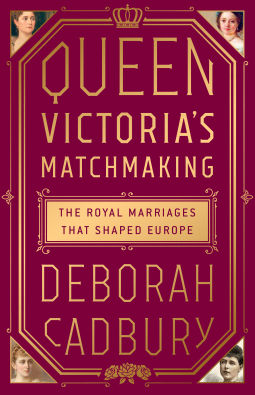
Queen Victoria's Matchmaking
The Royal Marriages that Shaped Europe
by Deborah Cadbury
This title was previously available on NetGalley and is now archived.
Send NetGalley books directly to your Kindle or Kindle app
1
To read on a Kindle or Kindle app, please add kindle@netgalley.com as an approved email address to receive files in your Amazon account. Click here for step-by-step instructions.
2
Also find your Kindle email address within your Amazon account, and enter it here.
Pub Date Nov 14 2017 | Archive Date Oct 26 2017
Perseus Books, PublicAffairs | PublicAffairs
Description
As her reign approached its sixth decade, Queen Victoria's grandchildren numbered over thirty, and to maintain and increase British royal power, she was determined to maneuver them into a series of dynastic marriages with the royal houses of Europe.
Yet for all their apparent obedience, her grandchildren often had plans of their own, fueled by strong wills and romantic hearts. Victoria's matchmaking plans were further complicated by the tumultuous international upheavals of the time: revolution and war were in the air, and kings and queens, princes and princesses were vulnerable targets.
Queen Victoria's Matchmaking travels through the glittering, decadent palaces of Europe from London to Saint Petersburg, weaving in scandals, political machinations and family tensions to enthralling effect. It is at once an intimate portrait of a royal family and an examination of the conflict caused by the marriages the Queen arranged. At the heart of it all is Victoria herself: doting grandmother one moment, determined Queen Empress the next.
Available Editions
| EDITION | Other Format |
| ISBN | 9781610398466 |
| PRICE | $27.00 (USD) |
| PAGES | 416 |
Links
Featured Reviews
 Susan R, Reviewer
Susan R, Reviewer
Prince Albert and Queen Victoria saw dynastic marriages between their children and European royalty as a safeguard against war, and as a way of creating a balance of power, in Europe, as well as spreading British values across the continent. With Prince Albert’s death, Queen Victoria was determined to make his vision come true and, with forty two grandchildren, the ‘cousinhood’ formed a unique club at the very top of European society. This book looks at Queen Victoria’s desire to be involved in matchmaking marriages for her grandchildren and looks, in greater depth, at seven of her grandchildren who were elevated to the throne at a crucial time in Europe’s history. These include Kaiser Wilhelm (her oldest, and most troublesome, grandson), Sophie, Queen of Greece, George V, Princess Maud, Queen of Norway, Alix, Empress of Russia, Marie ‘Missy’ Queen of Romania and Victoria Eugenie or ‘Ena’, Queen of Spain.
There is no doubt that Queen Victoria felt that, through her grandchildren, she could shape the political landscape of Europe. Although much of this book was familiar to me, such as Victoria’s desperate attempts to stop the marriage of Nicholas and Alexandra, Deborah Cadbury does include many snippets from personal letters from Queen Victoria and these make fascinating reading – especially her long correspondence with her eldest daughter, and mother of the Kaiser, Vicky. She does sometimes quote from other research , or authors, and I was not impressed by her taking one small piece of information from Patricia Cornwall; whose odd ranting about Jack the Ripper leads to any research she comes across being biased to concur with her bizarre theories and so is suspect in my eyes... That aside, the majority of the research comes from sources which are obviously directly from Victoria herself and makes the book, which could be all too familiar, come alive.
Queen Victoria comes across as a figure who is feared, and respected, in her family; the central character in a spider web which spreads across Europe. Her letters are manipulative, she is often insensitive and she is extremely demanding. Nor is she always successful in her attempts and some of the most interesting parts of this book deal with her failed attempts to create a marriage; such as her wishes to marry Prince Albert ‘Eddy’ to her beloved ‘Alicky,’ the later Empress Alexandra. However, even here, you can see how perceptive Victoria was; she thought Alicky’s ‘gauche’ qualities, such as her shyness and her dislike of social occasions, would be seen in England as a positive and make her liked by the press, and public, whereas they would be failings in the Russian Court. She correctly sensed danger for her favourite grand-daughter in Russia, and was also well aware of the dangers that being royal meant. Her ability to deal with Kaiser Wilhelm was not passed on by her son, who disliked the Kaiser, and, by her death, Europe was changing. Anarchy, revolution and war were in the air and Europe was on the brink of danger.
Overall, this is a very interesting read. The author really makes the time come alive and there are some very moving stories in this book, such as Prince Eddy’s attempts to find a bride and the fluctuating fortunes of Princess May of Teck; plus a lot of detail about other members of the royal family, as well as those featured. For anyone with an interest in British history, this is an enjoyable, well written, account of Queen Victoria’s attempts to manipulate her children’s, and grandchildren’s, marriages and to influence politics in Europe with mixed success. I received a copy of this book from the publisher, via NetGalley, for review.
Readers who liked this book also liked:
L.M. Montgomery, Crystal S. Chan, Kuma Chan
Children's Fiction, Comics, Graphic Novels, Manga, Teens & YA


















